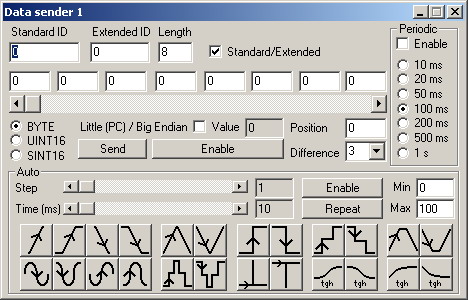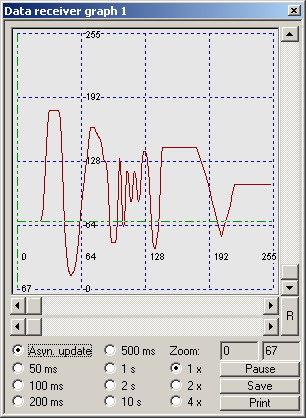
Data sender is designed to generate data sequence in CAN message and send it on the bus. You can quickly change the data value using mouse, scrollbar or automatically based on selected curve. The data is generated when dragging the scrollbar in manual mode. Set the minimum difference between sent data in Difference combo box. Alternatively, you can make the setting to generate the message periodically. It is then generated periodically within selected period regardless the change occurred or not. You can pick one of three generated data types: BYTE, SIGNED INT16 and UNSIGNED INT16. The data is placed starting data byte specified in the Position box. You can change the order of lower-upper byte (Endian) by checking the Little / Big Endian box.
In “automatic sequence” mode the data is generated based on the selected curve and you can specify the increment or the duration of one of possible statuses. Furthermore, you can set the data generation period and select to automatically repeat the curve.
Data receiver allows to picture data of selected message. You can select the message using identifier, identifier + first data byte, or identifier + first and second data byte. The Value box displays a Position (&Position+1) value that is of BYTE or UINT16 type. Press the Graph button to display the graph window that will provide you a synoptic data view.

V dialogu vyvolaném po stisknutí tlačítka Graph se zobrazují data přijatá pomocí Data receiveru. Update grafu je prováděn asynchronně (Asyn. update) s každou přijatou zprávou, nebo z posledních známých dat po uplynutí časového intervalu 50,100,200,500 ms nebo 1,2 a 10 s. V grafu je možno se pohybovat ovládacími scrollbary a prohlížet hodnoty dat pomocí kurzoru, který se po křivce dat pohybuje při tažení spodního horizontálního scrollbaru. Je možno zvolit 1,2 a 4-násobné zvětšení grafu. Tlačítko R je určeno k resetování ovládání grafu do defaultního nastavení. Hodnoty grafu je možno uložit do textového souboru tlačítkem Save nebo vytisknou tlačítkem Print. Tlačítko Pause je určeno pro zablokování příjmu dat do grafu.
Automatic sequences
In order to specify the behavior of automatic sequence, you must select the curve and specify the Step, Time, Min and Max parameters. Min and Max parameters specify the minimal and maximal sequence value. It depends on selected data type (BYTE, UINT16, SINT16). Set the Parameter Time within the range 10 - 10000 ms to specify message generating interval and new value calculation. Depending on selected sequence format you can specify the Step parameter to set the value and data incrementing type. In the following list the incrementing calculation is stated for each sequence.
 |
Progressive sequence. Step specifies the value of data sequence increment. |
 |
First, Step number of messages is generated with Min value. Next, each step increases the value by (Max-Min)/Step, so that after Step steps the sequence value reaches from starting Min value the Max value. Once the Max value is reached, Step number of messages is being generated with Max value. |
 |
Descending sequence. Step specifies the value of data sequence decrement. |
 |
First, Step number of messages is generated with Max value. Next, each step increases the value by (Max-Min)/Step. Once the Min value is reached, Step number of messages is being generated with Min value. |
 |
Triangular sequence. Data generation is started by incrementing the sequence from the Min value by Step for each step; once the Max value is reached, the sequence is decreased by a Step value until it reaches the Min value. |
 |
Triangular sequence. Data generation is started by incrementing the sequence from the Max value by Step for each step; once the Min value is reached, the sequence is increased by a Step value until it reaches the Max value. |
 |
First, Step number of messages is generated with Min value and Time interval between messages. Next, the Step number of messages is generated with Max value. |
 |
First, Step number of messages is generated with Max value and Time interval between messages. Next, the Step number of messages is generated with Min value. |
 |
First, Step number of messages is generated with Min value and Time interval between messages. Next, a Step number of messages is generated with (Max+Min)/2 value (mean value between Min and Max). Finally, the Step number of messages is generated with Max value. |
 |
First, Step number of messages is generated with Max value and Time interval between messages. Next, Step number of messages is generated with (Max+Min)/2 value (mean value between Min and Max). Finally, the Step number of messages is generated with Min value. |
 |
This sequence has four stages. First, increasing from Min to Max is performed by a (Max-Min)/Step. Next, Step number of messages is being generated with Max value. Next, the decreasing from Max to Min is performed. Finally, the Step number of messages is being generated with Min value. |
 |
This sequence has four stages. First, decreasing from Max to Min is performed by a (Max-Min)/Step. Next, Step number of messages is being generated with Min value. Next, the decreasing from Min to Max is performed. Finally, the Step number of messages is being generated with Max value. |
 |
The step value represents the angle increment in hundredths of degree. If Step = 100, the angle increment corresponds to one degree. The output value is then calculated this way: value(t) = ((Max-Min)/2) * (sin(t*Step/100)+1.0) |
 |
The step value represents the angle increment in hundredths of degree. If Step = 100, the angle increment corresponds to one degree. The output value is then calculated this way: value(t) = ((Max-Min)/2) * (cos(t*Step/100)+1.0) |
 |
The step value represents the angle increment in hundredths of degree. If Step = 100, the angle increment corresponds to one degree. The output value is then calculated this way: value(t) = ((Max-Min)/2) * (-sin(t*Step/100)+1.0) |
 |
The step value represents the angle increment in hundredths of degree. If Step = 100, the angle increment corresponds to one degree. The output value is then calculated this way: value(t) = ((Max-Min)/2) * (-cos(t*Step/100)+1.0) |
 |
This sequence has five stages. The first and the fifth stage generates Step number of Min values. The second and fourth stage generates Step number of (Max-Min)/2 values. The third stage generates Max value. |
 |
This sequence has five stages. The first and the fifth stage generates Step number of Max values. The second and fourth stage generates Step number of (Max-Min)/2 values. The third stage generates Max value. |
 |
First, Step values of Min is generated, then one Max value, and finally Step values of Min again. |
 |
First, Step values of Max is generated, then one Min value, and finally Step values of Max again. |
 |
For each step the value is defined this way: value(t)=((Max-Min)/2) + Max + tanh(t*0.01-(Step/100) ) * ((Max-Min)/2); |
 |
For each step the value is defined this way: value(t)=Max - ((Max-Min)/2) - tanh(t*0.01-(Step/100) ) * ((Max-Min)/2); |
 |
For each step the value is defined this way: value(t)=Min + tanh(t*0.01-(Step/100) ) * ((Max-Min)); |
 |
For each step the value is defined this way: value(t)=Max - tanh(t*0.01-(Step/100) ) * ((Max-Min)); |
